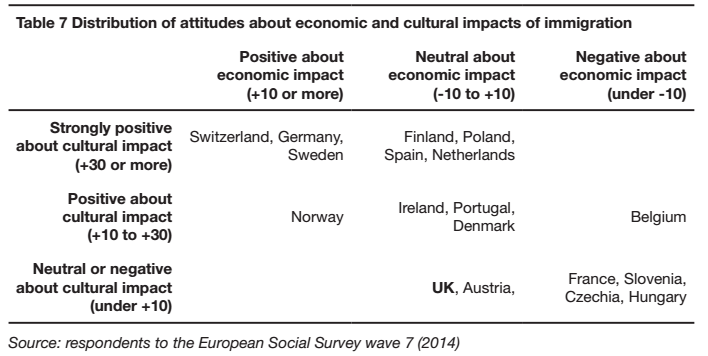European migration policy : between hysteria and opportunities
Currently, Europe faces a divide between contrasting attitudes towards migration both among Member States and inside society, as the debates on a common EU migration policy have highlighted. How can migration policy in general and labour market policies in particular contribute to lower the current tensions on the topic and offer realistic perspectives to newcomers in Europe? And how can Europe better attract talent?
Although high on the European political and media agenda, attitudes towards migration remain in average rather stable across Europe[1] with migrants primarily being perceived differently based on their ethnic background and country of origin[2].
Fragmented attitudes, diverging policies
Today, the young, the highly educated, the middle class and those with migrant heritage tend to be more positive about migration. By contrast, the old, those with few or no qualifications, the working class and those without any migrant heritage tend to be more negative[3]. When it comes to comparing states, the success of integration, in cultural and economic terms, is often linked to both public opinion and the type of migration policy. The relation between these two factors however remains controversial[4]:
 On the one hand, countries with inclusive migration, integration and labour market policies are also those whose citizens have more welcoming attitudes towards migration and lower levels of perceived threat. And on the other hand, countries with less inclusive migration, integration and labour market policies are also those with more citizens perceiving migrants as threats and tend to count a far lower number of migrants[5]. The overview (see table[6]) on a selected number of EU and non-EU Member States highlights the attitudinal differences in terms of cultural and economic effects of migration.
On the one hand, countries with inclusive migration, integration and labour market policies are also those whose citizens have more welcoming attitudes towards migration and lower levels of perceived threat. And on the other hand, countries with less inclusive migration, integration and labour market policies are also those with more citizens perceiving migrants as threats and tend to count a far lower number of migrants[5]. The overview (see table[6]) on a selected number of EU and non-EU Member States highlights the attitudinal differences in terms of cultural and economic effects of migration.
These findings highlight that high net migration levels per se do not lead to negative attitudes towards migration. The opposite may actually be true in certain circumstances[7]. Rather, a negative perception of the economic situation[8], fears over cultural identity and threat narratives in media and politics (e.g. about terrorism) seem to aliment negative views on migration[9].
Designing integration policies
Besides individual attitudes of residents, the public opinion and characteristics of the newcomers, solid public policies have proven to facilitate integration. The Migration Policy Index (MIPEX, a project managed by the Barcelona Centre for International Affairs, co-funded by the European Commission) for instance measures policies affecting migrants with the help of 167 indicators in various domains such as education, health and labour market policies. One of the core elements of integration, labour market participation, seems to be particularly crucial to it for cultural and economic reasons.
The analysis of the Index identifies best practice elements for labour market integration of migrants, irrespective of other public policy goals[10]: having the right to work, having equal opportunities on the labour market, being able to apply to public and private sector jobs in a timely manner after arrival, recognition of foreign qualifications, access to trainings/study grants, targeted offers like language or integration courses focused on the profession, job mentors and dedicated support staff in employment services, as well as equal workers’ rights once in employment.
High-skilled migrants
Turning to the more specific question of high-skilled non-EU migrants (who more than other profiles could represent a potential source of future managers for those countries with a lack of managerial workforce), Europe is equally fragmented when it comes to dealing with them. Although the share of high-skilled migrants among all migrants is growing to around 30% in OECD countries[11], European attempts to attract them, such as the Blue Card for high-skilled professionals, have remained low in scope and only attracted few. This stands against the background that the migration of high-skilled individuals is beneficial to Europe’s competitiveness, investments, innovation capacity and public finances (most pay taxes).
Due to very low levels of intra-EU labour mobility, skill shortages in the EU co-exist with high (youth) unemployment. Fostering labour mobility for EU citizens and third country nationals is therefore a key instrument to tackle these gaps, alongside measures to increase attractiveness.
If the principle of free movement of labour applies to EU citizens, this is not the case for (high skilled) third country nationals, who face hurdles when moving to and across the EU such as the recognition of official documents and qualifications, the language or work permits[12]. Pull-factors for high-skilled migrants include a higher salary, employment opportunities, stable institutional settings, social networks, (short) geographical distance, the social climate in the host country, but possibly also welfare state provisions[13].
To overcome the challenges mentioned and to make use of the opportunities migration offers, a better European migration policy framework is needed, allowing for clear legal migration channels. Even though there is significant disagreement among Members States on the scope and design of an EU migration policy, it seems clear that such policy can only succeed by building a coherent and integrated framework aligned to other public policy objectives, particularly in the domain of employment, labour market and social policies.
Sources:
[1] European Social Survey (ESS), p. 4 : https://www.europeansocialsurvey.org/docs/findings/ESS7_toplines_issue_7_immigration.pdf
[2] ESS, p.6 : https://www.europeansocialsurvey.org/docs/findings/ESS7_toplines_issue_7_immigration.pdf
[3] ESS, p.11 : https://www.europeansocialsurvey.org/docs/findings/ESS7_toplines_issue_7_immigration.pdf
[5] Ibid.
[6] Ford 2017, p. 144 : http://www.bsa.natcen.ac.uk/media/39196/bsa34_full-report_fin.pdf
[7] Bruegel 2018: http://bruegel.org/wp-content/uploads/2018/01/People_on_the_move_ONLINE.pdf?utm_content=bufferde11b&utm_medium=social&utm_source=facebook.com&utm_campaign=buffer
[8] IOM 2015, p.17 : https://publications.iom.int/system/files/how_the_world_gallup.pdf
[9] Overseas Development Institute 2017, p. 15 ff. : https://euagenda.eu/upload/publications/untitled-92767-ea.pdf
[11] 29% of migrants were tertiary educated, Nathan 2014: https://izajodm.springeropen.com/articles/10.1186/2193-9039-3-4
[12] Insituto Elcano 2013: http://www.realinstitutoelcano.org/wps/portal/rielcano_en/contenido?WCM_GLOBAL_CONTEXT=/elcano/elcano_in/zonas_in/TGAE-Gonzalez-Parkes-Sorroza-Ette-EU-global-competition-high-skilled-migrants
[13] Cebolla-Board 2017, p. 5 http://www.temperproject.eu/wp-content/uploads/2015/06/Working-Paper-9.pdf




